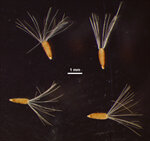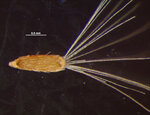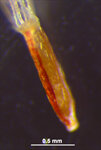Taxonomy
Conyza floribunda Kunth in A. von Humboldt et al., Nov. Gen. Sp. 4(fol.): 57. 1818; 4(qto.): 73. 1820.
The taxonomy of the species can be confusing: As of the time of writing, the Australian Plant Census does not consider C. floribunda to occur in Australia because the name was here misapplied to C. sumatrensis. However, C. bilbaoana occurs in Australia, and this name is considered to be synonymous to C. floribunda by the Flora of North America. This means that C. floribunda does occur in Australia, only under a different name.
Common synonyms
Erigeron floribundus (Kunth) Sch.Bip., Bull. Soc. Bot. France 12: 81. 1865, Conyza bilbaoana J.Remy, Fl. Chil. [Gay] 4(1): 76. 1849, Erigeron bilbaoanus (J.Remy) Cabrera, Revista Mus. La Plata, Secc. Bot. 2: 254. 1939.
Conyza is not distinct from Erigeron, and the name cited here as a synonym would be more scientifically correct. The species is retained here as a Conyza merely to avoid confusion.
Common name
Bilbao fleabane
Description
Propagule or dispersal unit is the fruit with pappus. Fertile part 1-1.8 mm long, 0.3-0.5 mm wide, in side view widest in upper part (obovoid) or widest in the middle, +/- straight, the upper (apical) end narrowing, in cross-section flattened, basal scar (carpopodium) pronounced and well-differentiated, central, rarely off to the side (oblique) or at least asymmetric, beak (=thinner sterile stalk between seed and pappus) absent, wings absent, fruit surface light brown or straw or reddish to pink, smooth (except at cellular level), with simple straight hairs, thickened margin absent or present (by misinterpretation), thick margin hairs simple straight hairs, longitudinal ribs absent or present, 2, their surfaces smooth, with simple straight hairs.
Pappus type bristles / hairs, pappus elements all +/- similar, up to 2-4 mm long, in one row, pappus elements numerous, persistent or elements falling off individually, the individual bristles rough / serrated (barbellate), +/- equal width along length, white / translucent.
Notes: The key accommodates the interpretation of surface structures either as two longitudinal ribs or as a thickened margin. The ribs are often dark reddish-brown. Unfortunately, the fruits of the various species of Erigeron / Conyza are all rather similar and hard to differentiate. Erigeron generally has an additional longitudinal rib on the fruit surface whereas Conyza generally has only the two marginal ribs or thickened margins, depending on interpretation.
Ecology
Annual to biennial herb, fruits wind-dispersed. Temperate to Meditteranean regions. Found on various disturbed sites such as roadsides, agricultural areas, urban areas, wastelands, etc.
Native range
South America.
Introduced range
United States (California), Central America, France, Portugal, Spain, tropical Africa (?), Australia, New Zealand.
Past interceptions (Australia): origins
United Kingdom, Spain, Germany, Slovakia, India, Korea, Japan, Thailand.
Unidentified species of the same genus from United States, Mexico, Colombia, Ecuador, Argentina, United Kingdom, Spain, Belgium, France, Germany, Italy, Hungary, Slovakia, Kenya, UAE, India, China, Korea, Japan, Thailand, Indonesia, Papua New Guinea, New Zealand.
Past interceptions (Australia): commodities
New vehicles.
Unidentified species of the same genus in/on machinery and parts, agricultural machinery, timber pallets, containers, nursery stock, new vehicles, cut flowers, steel, fresh fruit.


